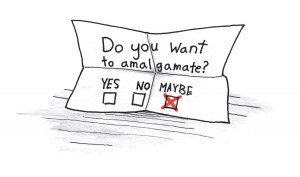
William Workman (graphic)
Campus regulars may have seen a metal line embedded in a concrete sidewalk between MacLaurin and Cornett, the marker that separates the Oak Bay side of the campus from the Saanich side. If supporters of amalgamation have their way, that line might become even more symbolic.
On July 24, Angus Reid Global released the findings of a poll commissioned by lobby group Amalgamation Yes that shows widespread support for greater co-operation between municipalities, driven by issues that transcend municipal boundaries.
According to their website, the Capital Region’s 350 000 residents are governed by 91 councillors and mayors in 13 separate municipalities. Amalgamation Yes argues that at minimum, eliminating duplicate fire chiefs and councillors would save money. To that end, they want a non-binding referendum question included on the November 15 municipal election asking voters whether amalgamation is a good idea.
With all the purported benefits, the concept of amalgamation isn’t perfect: bigger municipalities could impose their will on smaller ones, and survey respondents were afraid that regional concerns might be overlooked. For instance, Langford is pro-development, but Oak Bay is not. In the same vein, Saanich residents polled were less enthusiastic about amalgamation than Victoria residents.
It’s tough to imagine Sooke being lumped in with Oak Bay, but Amalgamation Yes is only interested in posing the question. Their site offers no specific plan for amalgamation, only suggestions, such as dropping from 13 municipalities to three (Westshore, Outer Communities, and Inner Communities). The amalgamation process would likely not consolidate the current municipalities into one large city, but simply reduce their number.
Though favorability varies from district to district, the poll found that 84 per cent of respondents are in favour of amalgamation (50 per cent strongly in favour, 34 per cent moderately so).
Local residents contacted through various community engagement events are concerned by a lack of integrated regional policing, a lack of regional transportation planning and traffic concerns, a problematic governance structure (e.g., an undemocratic CRD), a lack of sustainable community land-use planning, regional environmental concerns, and high taxes combined with unsustainable local municipal financing. All of these concerns are valid, and it is through discussion that these concerns were discovered. Why not take the consultation to the next logical phase by asking voters on the ballot? The more that people dig into the pros and cons, ideally, the closer it will take us to the solution.
The upcoming municipal election on Nov. 15 is likely to be a referendum on three issues: sewage treatment, the Johnson Street bridge, and transit. Those large-scale projects would undoubtedly be affected if the CRD’s structure were to change. If the public is hungry for change, our local government would be well-advised to start a dialogue.








